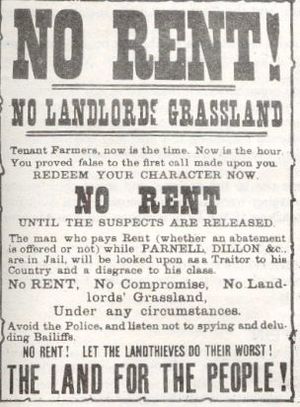Irish National Land League facts for kids
Quick facts for kids
Irish National Land League
Conradh na Talún
|
|
|---|---|

Irish landlord reduced to begging for rent, 1880 caricature
|
|
| Abbreviation | INLL |
| President | Charles Stewart Parnell |
| Secretary | Andrew Kettle Michael Davitt Thomas Brennan |
| Founded | October 21, 1879 |
| Dissolved | October 17, 1882 |
| Succeeded by | Irish National League |
| Ideology | Agrarianism Irish nationalism |
| Political position | Centre-left |
The Irish National Land League (Irish: Conradh na Talún) was a political organisation in the late 19th century Ireland. It sought to help poor tenant farmers. Its primary aim was to make it possible for tenant farmers to own the land they worked on. This was known as the Land War.
Background
In 1874 prices on agricultural produce in Europe dropped. This was followed by several years of bad harvests caused by wet weather during the Long Depression. As a result, by 1878 many Irish farmers were unable to pay the rents that they had agreed, particularly in the poorer and wetter parts of Connacht. The 1879 Famine added to the misery.
League founded
The Irish National Land League was founded at the Imperial Hotel in Castlebar, on 21 October 1879. Charles Stewart Parnell was elected president of the league. Andrew Kettle, Michael Davitt and Thomas Brennan were appointed as honorary secretaries.
The two aims of the Land League were:
- to put an end to an unjustly excessive rent (the word "rack" means the medieval torture device), paid by tenant farmers.
- to make it possible for the farmers to own the land they worked on.
Charles Stewart Parnell, John Dillon, Michael Davitt, and others then went to the United States to raise funds for the League. Branches were also set up in Scotland.
The government had introduced the first Land Act in 1870, which proved largely ineffective. It was followed by Land Acts of 1880 and 1881. These established a Land Commission that started to reduce some rents.
Although the League discouraged violence, crimes increased widely. Typically a rent strike would be followed by eviction by the police. Tenants who continued to pay the rent would be subject to a boycott.
In the United States
The Land League had a similar organization in the United States, which raised hundreds of thousands of dollars both for famine relief and also for political action.
Land war
From 1879 to 1882, the League organized what came to be known as "Land War". Its members put up a strong resistance to evictions, reductions in rents and aided the work of relief agencies. Their set of demands were known as the "Three Fs":
- Free sale— meaning a tenant could sell the interest in his holding to an incoming tenant without landlord interference;
- Fixity of tenure— meaning that a tenant could not be evicted if he had paid the rent;
- Fair rent — meaning rent control
The "Ashbourne Act" passed in 1885 made it unprofitable for most landlords to evict. By then agricultural prices had made a recovery, and rents had been fixed and could be reviewed downwards, but tenants found that holding out communally was the best option.
A renewed Land War was waged under the Plan of Campaign from 1886 up until 1892 during which the League decided on a fair rent and then encouraged its members to offer this rent to the landlords. If this was refused, then the rent would be paid by tenants to the League and the landlord would not receive any money until he accepted a discount.
Many landlords resisted these tactics, often violently and there were deaths on either side of the dispute.
As a result of the Land War, the Irish National Land League was suppressed by the authorities. In October 1882, as its successor Parnell founded the Irish National League to campaign on broader issues including Home Rule. Many of the Scottish members formed the Scottish Land Restoration League. In 1881, the League started publishing United Ireland a weekly newspaper edited by William O'Brien, which continued until 1898.
Outcomes
As a result of the Land War, a series of Irish Land Acts were introduced.
The Land Purchase (Ireland) Act 1903 allowed Irish tenant farmers to buy out their freeholds through the Land Commission. To purchase land, farmers could obtain loans from the UK government. Such loans had to be paid off within 68 years. The act finally helped resolve the Irish Land Question.
Under the Labourers (Ireland) Act 1906 and the Labourers (Ireland) Act 1911 40,000 new rural cottages were built, each on an acre of land. By 1914, 75% of occupiers were buying out their landlords, mostly under the two Acts.
In all, over 316,000 tenants purchased their holdings amounting to 15 million acres (61,000 km2) out of a total of 20 million acres (81,000 km2) in the country.
See also




